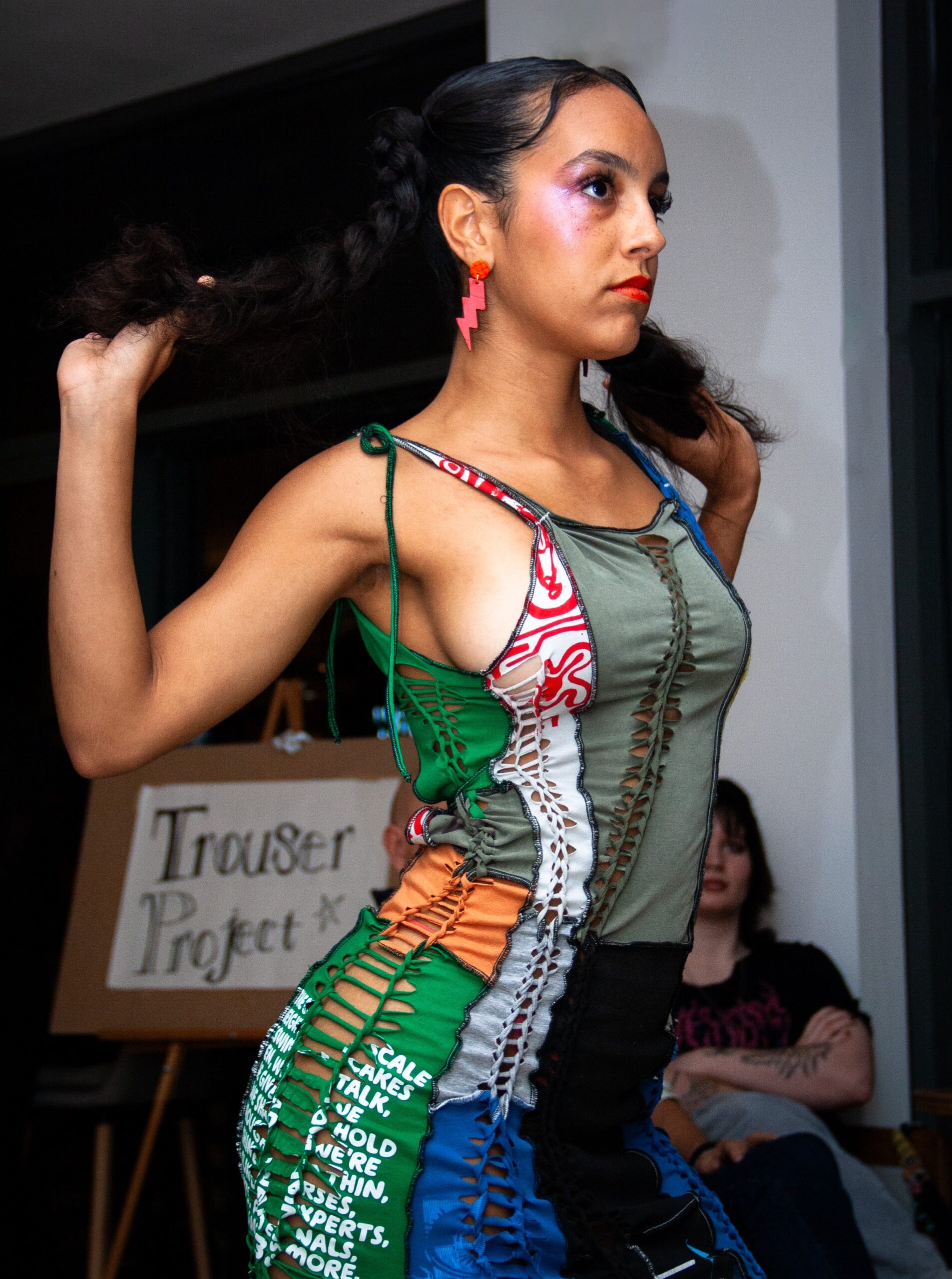Last week, Brighton was buzzing with excitement as the Brighton Fashion Collective hosted Brighton Sustainable Fashion Week, a celebration of eco-conscious style, innovative design, and ethical fashion practices. The event brought together sustainable designers, makers, activists, and fashion enthusiasts from across the country.
Highlights include panel discussions on the future of sustainable fashion, workshops on upcycling and zero-waste design, and a pop-up market, at the iconic Brighton Dome, showcasing unique, eco-friendly brands and independent makers pushing the boundaries of ethical fashion.
Kicking off the festivities, I had the pleasure of attending the launch party at Helm Gallery, which featured a taster runway show spotlighting the work of up-and-coming sustainable designers including my daughter Megan Lewis @Trouser Project . Their creativity and commitment to sustainability piqued my interest, leading me to reflect on the disconnect between the high-street fashion industry and the growing movement toward more responsible, environmentally friendly fashion practices.
So I did some digging…

Dress by Trouser Project Earrings @lunadesignsurrey Model @lilaskyeee Photography @beasphotos
The fashion industry, long known for its creativity and innovation, faces a significant challenge as we stand at the crossroads between fast fashion and sustainability. While high-street fashion brands continue to dominate, churning out affordable, trendy clothing at lightning speed, a growing wave of sustainable fashion designers and makers is working tirelessly to shift the narrative toward environmental responsibility. The disconnect between these two worlds has never been more evident, and with the increasing environmental toll of fast fashion, it’s time to address what needs to change. A critical question remains: How do we make sustainable choices the norm across all generations, and not just (predominantly) the younger, eco-conscious Gen Z?
The Fast Fashion Problem
Fast fashion’s allure is undeniable—its affordability, accessibility, and rapid turnover of trends appeal to consumers looking for fresh styles without breaking the bank. Brands like Zara, H&M, and Shein have mastered this business model, but the environmental consequences are staggering. The fashion industry is responsible for 10% of global carbon emissions, not to mention water pollution, textile waste, and the widespread use of synthetic fibres that take centuries to decompose.
The convenience and low cost of fast fashion come at a steep price. Each year, millions of tons of clothing end up in landfills, and the resources used to produce and transport these garments contribute significantly to climate change. Workers in fast fashion supply chains often face poor working conditions and low wages, compounding the ethical issues surrounding the industry.
Enter the Sustainable Fashion Movement
On the other side of the fashion spectrum, sustainable designers and makers are rising, advocating for slow fashion—a model that emphasises quality over quantity, ethical production methods, and environmental responsibility. These designers focus on creating timeless pieces, often made from organic or recycled materials, and employ transparent, ethical production practices.
The growing presence of these designers and brands, such as Patagonia, Stella McCartney, and smaller, independent labels, is helping to reshape how we think about fashion. They are pushing for a shift away from fast fashion’s throwaway culture towards a more mindful approach to clothing. However, there is still a considerable gap between their ethos and the mainstream high-street fashion industry. Price is one factor—sustainable fashion can be more expensive due to higher production costs and the use of eco-friendly materials—but there is also a cultural gap. Many consumers, especially older generations, remain loyal to fast fashion’s affordability and convenience, unaware of the environmental and ethical costs.
Closing the Gap: What Needs to Change?
To close this gap, several key steps need to happen, both within the industry and among consumers.
1. Greater Transparency from High Street Brands
High Street fashion brands must take accountability for their environmental impact. They should be more transparent about their supply chains, materials, and production methods. Some brands are starting to incorporate more sustainable practices, but these efforts often feel tokenistic, such as “greenwashing,” where small, eco-friendly initiatives are used as a marketing tool without addressing the deeper environmental issues. Genuine efforts to reduce waste, lower emissions, and promote circular fashion (where products are designed to be recycled or reused) are essential.
2. Education and Awareness Across Generations
While Gen Z is often hailed as the sustainability-savvy generation, older generations need to be brought into the conversation. Education is key. Sustainable fashion needs to become more accessible, not only in terms of price but also in understanding. Many older consumers may not be aware of the environmental impact of their choices, so brands, influencers, and even governments must focus on educating the public. Social media has played a huge role in spreading awareness among younger people, but other channels—like television, print media, and in-store campaigns—can be used to reach older generations.
3. Making Sustainable Fashion Affordable and Accessible
To make sustainable fashion the new norm, it needs to be as affordable and accessible as fast fashion. This requires systemic change. Governments can help by offering tax incentives to brands that adopt sustainable practices or penalising those that don’t. Additionally, innovations in technology, such as biodegradable materials and zero-waste manufacturing techniques, will play a crucial role in reducing costs over time, making sustainable fashion more competitive with fast fashion.
4. Changing Consumer Habits Across Generations
Creating lasting change means altering consumer habits. All generations, from Baby Boomers to Gen Z, need to embrace the idea of buying less but buying better. Consumers can be encouraged to repair, recycle, and upcycle their clothes instead of constantly purchasing new items. This shift in mindset will require cultural change, and it’s up to both brands and governments to incentivise sustainable choices.
A Sustainable Fashion Future for All
The disconnect between the high street fashion industry and the up-and-coming sustainable designers is real, but it doesn’t have to be permanent. By promoting transparency, educating consumers across generations, making sustainable fashion affordable, and changing consumer habits, we can shift the paradigm toward a more responsible future. Fast fashion’s dominance may still reign for now, but with collective effort, we can make the sustainable choice the new normal—across all ages, not just the younger, eco-conscious generations. The future of fashion, and the planet, depends on it.
